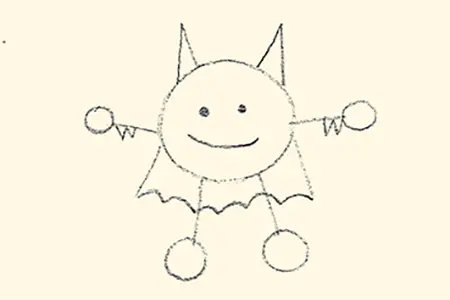Why I Make Art
My earliest memories are of drawing. The images in my head are quite distinct – sunlight streaming into my living room, four- (maybe three-?) year-old me lying on the floor, crayons and paper laid out before me, drawing Batman. It looked something like this:

I like to think my work has improved in the intervening decades. At the very least, I have a better understanding of human anatomy (yes, people DO have torsos). But the deep-seated urge to reproduce my world on paper has never left me.
It’s not that I’ve locked myself away in the studio to draw or paint. There were lots of wasted years in this regard, years when my production was limited to surprisingly detailed doodles in the margins of meeting agendas. Or gently mocking caricatures of friends and coworkers. Or more pictures of Batman (that hasn’t left me, either).
But I always saw the world with an artist’s eye. I would study faces, asking myself, “How would I draw that person?” I would look down streets, mentally tracing lines of perspective to determine vanishing points. I would come upon a scene perfect for a still life and shuffle back and forth, searching for the most visually appealing angle from which to depict it. Essentially, I processed the world as a piece of art waiting to happen.
So when, about 10 years ago, I set out on my Artistic Journey, it wasn’t so much a decision as a surrender. Some deep-seated part of my brain was calling out to me, and the only way to shut it up was to translate all that noise to images. If any of us is meant to do anything, I was meant to make art.
Which isn’t to say I make great art, or have some miraculous natural aptitude. This stuff is hard. There are lots of pieces that can only be described as “unsuccessful.” But the joy is in the process. When pencil touches paper or brush touches canvas, I find my own, personal Zen. My entire universe is reduced to that tiny point, and everything hinges on the rightness or wrongness of the mark.
Does that sound a little insane? For me, the benefits are immeasurable. Life is complicated and challenging and frustrating. Art simplifies all of it, and provides a framework that lets me get out of my head. Conversely, when circumstances prevent me from drawing or painting for a day or two, the absence gnaws at me. I get grumpier. I feel tense. Art is the release.
I’ve discovered other, equally meaningful benefits:
Making art changes how we see the world. William Butler Yeats wrote, “The world is full of magic things, patiently waiting for our senses to grow sharper,” and the dude was onto something. These days, everywhere I look, I see moments, people, objects that are beautiful, that demand to be captured and shared. My eye is more attuned to nuances of color and contour. I can identify each of the different cardinals who live in the trees behind my back fence by subtle differences in shape and even bearing. Could I see and appreciate all of these things without drawing and painting them? Of course. Would I have seen and appreciated them if I wasn’t looking through the eyes of an artist? Maybe not.
I enjoy dealing with the technical challenges of art, whatever the medium (and I have a terrible time settling on a single medium). There is no end to the list of problems to address in translating a three-dimensional world to a two-dimensional surface. How do you make grass look like grass without painting every piece of grass? How do you make a surface look shiny? How do you guide the viewer’s eye to your chosen center of interest? I love looking for and experimenting with answers to questions like these. Even more, I love exhilaration of discovery when something actually works.
Art lets us communicate with others across time and space. It’s rewarding to know that something I’ve created hangs in a person’s home and, maybe, provides a little bit of joy each time they pause to look at it. It’s also gratifying to think the energy and emotion that went into creation somehow resonates with viewers, and might continue to do so long after I’m gone.
So when someone asks me why I’m compelled to make art, the question sort of answers itself. The real question is, why would I not? Art is the language that helps me process the world. Just as writing helps me understand what I think, drawing and painting help me appreciate what I see. Art is also a limitless source of technical challenges and rewards. It’s a release, a tool to sharpen my sense, and the means by which I share my perspective with others.
